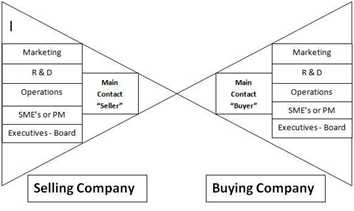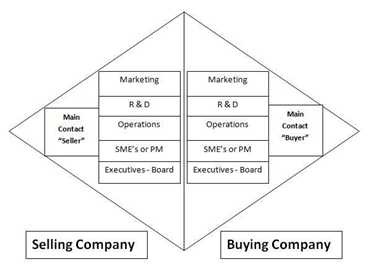Key Account Management: Avoiding the “Bow-Tie” Resource Approach

The questions are:
- How are your resources aligned?
- Are they the right resources?
- Are you single-threaded within the account?
When it comes to KAM & GAM, most of the companies competing for the business offer good products and services, so what is the difference-maker? It’s not only the people within the account team but the depth and breadth of the client relations.
The common mistake made by most companies is that after the initial sale the level of resource involvement tails off. The “key” to any key account program is developing and maintaining the relationships long after the initial engagement.
Some may say “thank you for stating the obvious”, others may say, “why do I care I’m not incented to go beyond the initial product or solution offer”. Let’s face it the traditional bow-tie relationship (figure 1) is simple, provides a high level of control, and typically creates no surprises between the buyer and seller points of contact.
The following are just 6 reasons the traditional bow-tie approach fails or does not yield the value planned for from the Key Account:
- No penetration of the account beyond the initial contact or no depth & breadth
- Limited account or client business understanding
- Limited solution selling opportunities (both sides: customer doesn’t know you offer other products & services and therefore the seller is unaware of the additional prospects within the account)
- Heavily reliant on 2 individuals
- Leaves the door wide open to competitors
- With the limited penetration into the account, the likelihood of a large complex sale is slim to none

Figure 1: The bow-tie relationship
Adapted from Cheverton, P: Global Account Management and McDonald M, Millman, AF, and Rogers, B: Key Account Management: Learning from the supplier and customer perspectives
The solution to the traditional bow-tie approach is the cross-functional team matching buyer & seller resources (expert to expert), educating, learning, and understanding (Diamond Relationship: figure 2) the value each party provides. The result; you’re viewed as a “problem solver”, developing “trust” and considered part of the team, not an outsider:
Figure 2: The diamond relationship
Adapted from Cheverton, P: Global Account Management and McDonald M, Millman, AF, and Rogers, B: Key Account Management: Learning from the supplier and customer perspectives
The 4 success criteria of the Diamond Relationship are:
- Research: do your homework, know the customers business better than your own
- Patience: these success stories take time, they will have their ups and downs, don’t panic
- Relationship map: a matrix of key contacts within the account aligned with their peer within your company
- Teamwork: groups or key account teams of 3 ("A" Players) and greater, all rowing in the same direction.
Some may say you know when you’ve arrived when the teams on both sides understand their roles, purpose, requirements, and the program plan. From a seller perspective you know you’ve arrived when you’re invited to internal meetings by the buyer involving annual planning, strategic direction, or meetings slightly outside of your core but where the client believes you can add value or at a minimum wants your opinion.
So we are developing our key account diamond approach, aligning resources, and getting invites to meetings outside my core competency, how do I measure the success of the relationship? In my next post, I will discuss the details of the key account scorecard.